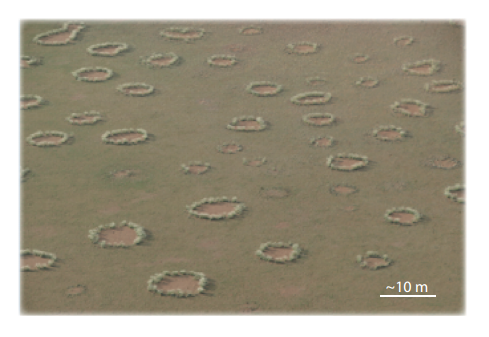
© MIT Technology Review
Fairy circles are mysterious barren patches of land that are surrounded by healthy vegetation. The circles are common in many parts of the world but particularly in the arid grasslands of southern Africa where they range in size from 2 metres to 10 metres across (see picture left).
Plant biologists know these circles are stable having watched them over periods of decades. So these structures are clearly no accident. Indeed, exactly why fairy circles appear is something of a mystery. In particular, nobody has been able to explain why the patches are circular and not some other shape.
That changes today thanks to the work of Cristian Fernandez-Oto at the Université libre de Bruxelles in Belgium and a few pals who have used computer simulations to show that fairy circles are emergent patterns that occur naturally when plants compete for water in arid conditions.
Their model is relatively straight forward. It is based on the fact that a single plant can generate a root system below ground that is many times larger than the structure above the surface. The size of these roots determines how close together the plants can grow.
Next they assume that the land can exist in two stable states: either it is uniformly covered in vegetation or uniformly devoid of vegetation.
The interesting behaviour occurs when both states exist at the same time. In that case, there must be a "front" that connects the barren and fertile regions.
Fernandez-Oto and co specifically focus on the behaviour of this front in their model. They show that when a barren region shrinks, the plants along the front get closer together and their root systems begin to interact.
Since the plants cannot get closer together than the root system allows, the contraction stops when the barren patch shrinks to a certain size. And the most efficient packing of plants around this front is clearly when it is a circle. Voila!
What's interesting about the model is that it predicts that the circles should be bigger in more arid regions where the competition between plants for water is higher. This causes them to grow bigger root systems and ensures that they must remain further apart. Hence, bigger fairy circles.
And that's exactly what plant biologists observe. In the grasslands of southern Angola, Namibia and South Africa, there is a clear correlation between the size of fairy circles and the availability of water. In the northern part of this region, which is closer to the equator and drier, the circles have an average diameter of 10 metres whereas the more southerly circles have an average diameter of just 2 metres.
"Our analysis explain how a circular shape and fringes are formed, and how the aridity level influences the size of the fairy circles," they say.
That's a useful result particularly since the mathematical model behind the results is applicable to other systems that share the same characteristics. That means any system that consists of units that compete for a limited resource in a region in which they can both flourish or die away.
It's not hard to imagine systems in which this might be satisfied, such as the spread of epidemics, wars or products in trading zones. Whether there are examples of fairy circles in these kinds systems is an interesting question. Answers in the comments section please.
Reference: Strong Interaction Between Plants Induces Circular Barren Patches: Fairy Circles
Reader Comments
to our Newsletter